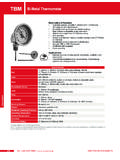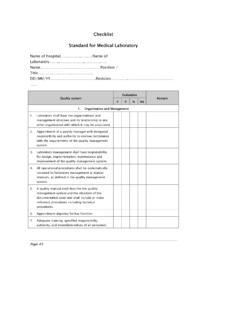Transcription of Pressure Gauge Installation, Operation and …
1 WINTERS INSTRUMENTSMANUFACTURER OF INDUSTRIAL Gauge installation , Operation and MaintenancePressure GaugesTel: 1-800-WINTERS / WINTERS INSTRUMENTSO peration and maintenance of a Pressure GaugeInspection FrequencyThe frequency of inspection is dependent on the severity of service and how critical the accuracy of the indicating Pressure . The inspection frequency can range from monthly to annual basis. To ensure the accuracy of your Pressure readings, it is strongly recommended that all Pressure gauges be recalibrated and certified each year. Winters provides test certification that are traceable to the National Institute of Standards and Technology (NIST).
2 Isolating ValvesIt is recommended that isolating valves be fitted with the Gauge . This enables the Gauge to be removed at any time for checking, recalibration or replacing without interruption to the process. The valves should be opened or closed slowly to avoid sudden changes to Pressure being applied to the Gauge . It is recommended for systems that have an abrupt Pressure surge at start-up to close the valves during initial start-up. Winters carries various types of wetted parts are suitable for use on the following types of media: air, oil, water and other non-corrosive fluids.
3 For corrosive fluids, stainless steel should be specified. For special applications, other materials such as Monel can be used as well. Diaphragm seals may also be considered. Please consult Winters Instruments for pressures are expected to pulsate violently, oscillate with high frequency or occur with sudden shock, a snubber should be considered. Winters snubbers incorporate a sintered porous 316 stainless steel snubbing element with a large surface area to ensure long term effectiveness on most Pressure media. Snubbers are available in three viscosity classifications: heavy oil, water and air.
4 Brass, stainless steel or Monel housing can be specified depending on the media Pressure gauges should be placed in dry storage under ambient room temperatures. It is recommended to store Pressure gauges in their original packing normal ambient temperature ranges are -40 C to 120 C (-40 F to 250 F) for dry gauges and -20 C to 65 C (-4 F to 150 F) for glycerin filled gauges. Process temperature up to 400 C (752 F) can be accommodated when a Gauge is dry AND appropriate external cooling is applied. In situations where the process temperature is extreme, utilizing a syphon or remote mounting the Pressure Gauge with a capillary and diaphragm seal are reasonable alternatives.
5 In general, a Gauge is unduly hot if it cannot be grasped by hand without discomfort. It should be noted that gauges used on water might burst if exposed to is a registered trademark of Inco Alloys InternationalVibrationVibration can affect the dial reading of Pressure gauges. These areas should be avoided as much as possible. Vibration effects can be minimized by the use of a dampening liquid such as glycerin or silicone. If vibration is extreme, then a flexible tube connected to an appropriate diaphragm seal should be considered. A Winters StabiliZR movement can also be used to improve dial GaugesWINTERS INSTRUMENTS Tel: 1-800-WINTERS / of a Pressure GaugeLocationVibration and extreme ambient temperatures can affect the dial reading of the Pressure Gauge .
6 These areas should be avoided as much as suitable thread sealant is required for NPT threads such as pipe dope or PTFE tape. The Gauge should only be installed by hand until the first 2 threads engage. This will allow the Gauge socket thread to be seated correctly. An open ended wrench should then be used on the socket flats to tighten the Gauge . DO NOT tighten the Gauge by hand, otherwise it will severely damage the Gauge . Venting ProceduresDue to Pressure build up, some gauges (usually lower Pressure ranges such as vacuum, up to 100 psi) may reflect a reading that is slightly off zero.
7 To properly vent the Pressure Gauge , cut off the tip of the fill plug after you have installed the instrument. This allows the Gauge to be equal to the atmospheric Pressure . Venting can also be achieved by lifting the stainless steel or brass vent plug for a moment and re-seating (closing) it. In either case, the Gauge should be installed in an upright position to avoid the liquid from ProceduresInspect the Pressure Gauge for zero reading when there is no applied Pressure . In many cases, the Gauge pointer can simply be adjusted for the Gauge to work within specifications.
8 However, if the Gauge requires calibration, then follow the procedures below*.1. Remove the ring and lens2. Slowly pressurize the Gauge to its full scale and slowly release the Pressure back down to zero3. Check the Gauge at a minimum of four equal Pressure intervals against a certified test Gauge *4. Adjust the movement accordingly by removing the pointer with a pointer extractor. Be careful not to bend the pointer shaft5. Remove the dial plate by loosening the holding screws6. When adjustments are completed, replace the dial plate and pointer7. Re-check the Gauge for accuracy8.
9 Check lens assembly gasket for any deformation, tears or cracks. If there are any visual defects, contact Winters to get a replacement gasket9. Re-assemble the lens assembly*Winters can recalibrate and provide test certificates that are traceable to NISTR eplacing The LensTo replace a broken lens, check to see if the lens is held on by a bayonet or snap-on ring. To remove a bayonet ring, unscrew using a rubber belt wrench. To remove a snap-on ring, remove any screws holding the ring in place then pry off the ring with a small screwdriver. Remove all glass chips, insert new lens and re-insert the bayonet or snap-on ring.
10 With snap-on rings, locate the ring joint at the bottom of the Gauge . Crimp-on rings cannot be replaced once removed. If you would like to replace the lens or remove/replace crimp-on rings, please contact The PointerRemove the bayonet or snap-on ring as previously described above. Remove old pointer with pointer extractor or two small screwdrivers opposite each other under pointer hub. Pry off evenly, being careful not to bend the pointer shaft. Install the new pointer on zero. NOTE: Gauges with a zero stop pin must have the pointer set at a reference Pressure (preferable mid-scale) to offset the preload against the stop pin.









